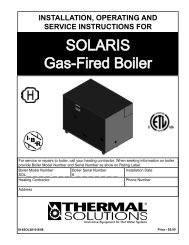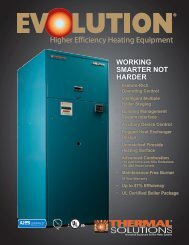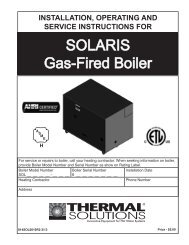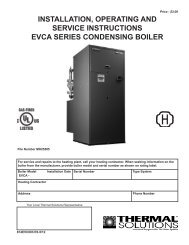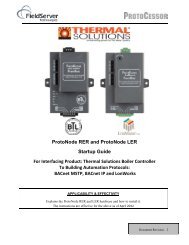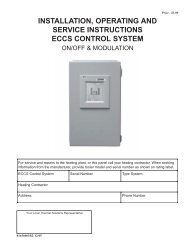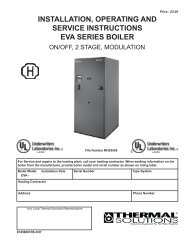I&O Manual - Solaris Water Heaters - Categories On Thermal ...
I&O Manual - Solaris Water Heaters - Categories On Thermal ...
I&O Manual - Solaris Water Heaters - Categories On Thermal ...
You also want an ePaper? Increase the reach of your titles
YUMPU automatically turns print PDFs into web optimized ePapers that Google loves.
V. Gas PipingWARNINGFailure to properly pipe gas supply to waterheater may result in improper operation anddamage to the water heater or structure. Alwaysassure gas piping is absolutely leak freeand of the proper size and type for the connectedload. An additional gas pressure regulatormay be needed. Consult gas supplier.A. Size gas piping. Design system to provide adequate gassupply to water heater. Consider these factors:1. Allowable pressure drop from point of delivery towater heater. Maximum allowable system pressureis ½ psig. Actual point of delivery pressure may beless; contact gas supplier for additional information.The minimum and maximum gas valve inlet pressureis stamped on the rating label and can be foundin table 3.2. Maximum gas demand. Refer to the water heater’sinput found in Figure 1 or as printed on it’s ratinglabel. Also consider existing and expected futuregas utilization equipment (i.e. water heater, cookingequipment).3. Length of piping and number of fittings. Refer to Table5 for maximum capacity of Schedule 40 pipe. Table 6lists equivalent pipe length for standard fittings.Table 3: Gas Ratings<strong>Water</strong>heaterModelMaximumGas Pressure(in. w.c.)MinimumGas Pressure(in. w.c.)ManifoldPressure(in. w.c.)SOL-500 14 4.5 1.34. Specific gravity of gas. Gas piping systems forgas with a specific gravity of 0.70 or less can besized directly from Table 5, unless authority havingjurisdiction specifies a gravity factor be applied.For specific gravity greater than 0.70, apply gravityfactor from Table 4. If exact specific gravity is notshown choose next higher value.Table 4: Specific Gravity Correction FactorsSpecificGravityCorrectionFactorSpecificGravityCorrectionFactor0.50 1.10 1.10 0.740.55 1.04 1.20 0.710.60 1.00 1.30 0.680.65 0.96 1.40 0.660.70 0.93 1.50 0.630.75 0.90 1.60 0.610.80 0.87 1.70 0.590.85 0.84 1.80 0.580.90 0.82 1.90 0.561.00 0.78 2.00 0.55For materials or conditions other than those listed above, referto National Fuel Gas Code, NFPA54/ANSI Z223.1,or size system using standard engineering methodsacceptable to authority having jurisdiction.B. Connect water heater gas valve to gas supply system.1. Use methods and materials in accordance with localplumbing codes and requirements of gas supplier. Inabsence of such requirements, follow National FuelGas Code, NFPA 54/ANSI Z223.1.2. Use thread (joint) compounds (pipe dope) resistantto action of liquefied petroleum gas.3. Install sediment trap, ground-joint union and manualshut-off valve upstream of water heater gas controlvalve and outside jacket. See Figure 14.WARNING4. All above ground gas piping upstream from manualshut-off valve must be electrically continuous andbonded to a grounding electrode. Do not use gaspiping as grounding electrode. Refer to NationalElectrical Code, NFPA 70.C. Pressure test. The water heater and its gas connection<strong>Water</strong> heaters installed between 0 and 2,000 feet above sea level use fuel inputs listed in the“General Ratings and Capacities” table found at the beginning of this manual. For water heatersinstalled above 2,000 feet, reduce gas input by 4% for each additional 1,000 feet above sealevel, as per NFPA 54.25



